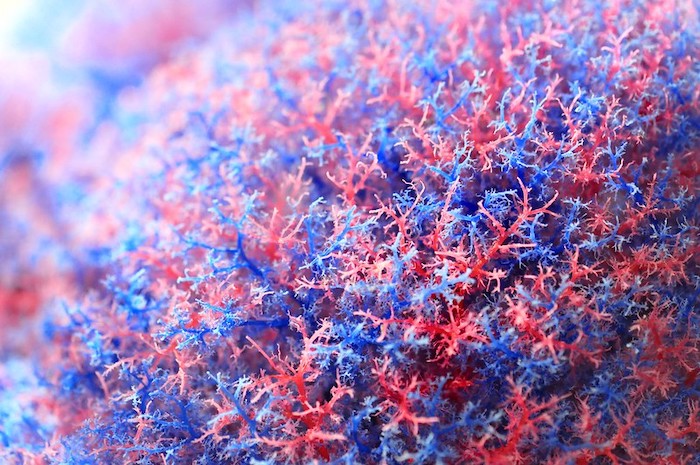Discovery of thiabendazole target explains vascular disrupting action.
Even after hundreds of millions of years of evolution, some yeast genes persist mostly intact in humans and other vertebrates. Despite the huge differences between yeast and humans, these genes perform the same molecular function in both organisms but have been adapted over time into new contexts. Learning about these evolutionarily enduring genes can provide important insight into complex systems in large organisms.
About a decade ago, researchers led by molecular biologist Edward Marcotte and John Wallingford of the University of Texas at Austin discovered that a medication used to treat fungal infections and ringworm could also stop new blood vessel formation in vertebrates. The drug, called thiabendazole (TBZ), would even cause recently formed blood vessels to break apart and dissolve. Although TBZ had been in clinical use for decades, nobody knew exactly how the drug worked at the molecular level.
Now, in a new paper in GENETICS, Marcotte and colleagues have identified the molecular target of TBZ’s blood vessel-disrupting action. It’s called beta-tubulin 8, or TUBB8, a structural protein that helps provide the cell’s skeletal system. The discovery explains why TBZ kills fungi but not vertebrates.
Studying human genes in yeast
The story began with the realization that certain interacting networks of genes needed for survival in single-celled organisms like yeast had survived billions of years of evolution and remained active in vertebrates, including humans.
“They’re inherited intact as a system,” Marcotte explains. As new organisms emerged through evolutionary processes, they developed different body plans and ecological niches. During these changes, many gene networks continued working together, but were recruited to different systems in different organisms.
“In yeast, they get wired up to do one thing, and ultimately in the vertebrate lineage they get wired up to do something else,” Marcotte says. “That’s the kind of process we’re talking about.”
Studying these networks revealed that a set of genes that keep the yeast cell wall intact also help blood vessels grow properly in vertebrates. This led to the discovery that TBZ could stop blood vessel formation.
“That discovery got us really intrigued about the extent that human and yeast genes were still doing the same thing,” says Marcotte. “Questions like that made us wonder how much yeast and human genes were still equivalent.”
To study the questions, the researchers created strains of yeast in which they substituted the original yeast gene with its human counterpart. In cases where the human gene adequately sufficed for the lost yeast gene, the “humanized” strain of yeast became a valuable research tool. They successfully created several hundred of these strains.
“What’s great about yeast is that we can study human genes in a simplified context,” says Riddhiman Garge, the paper’s co-first author, who is now a postdoctoral fellow at the University of Washington and performed the work collaboratively with researcher Hye Ji Cha.
Tracing the tubulin family tree
TBZ, they knew, killed yeast by disrupting a structural protein called beta-tubulin. While yeast have one beta-tubulin gene, humans have accumulated nine versions of the gene, and two of them can substitute for the yeast gene.
“We used molecular modeling to build models of the yeast beta-tubulin and the various beta-tubulins in humans,” Marcotte says. Using these computer models, they simulated interactions between TBZ and each tubulin.
“Out of the nine beta-tubulins, only one looked like it would actually be responsive to the drug,” says Marcotte.
Over the course of evolution, the one beta-tubulin ancestral gene had been copied and changed until humans had 9 beta-tubulins. Eight of them contain naturally occurring mutations that confer resistance to TBZ. The one that doesn’t, TUBB8, is expressed in blood vessels.
“Thiabendazole doesn’t kill humans, like it does fungus and nematodes, because most human cells have resistant forms of tubulin,” Marcotte says. “It’s known to have a very good safety profile over the decades of use. This result explains why that’s the case, but also explains why it turns out to be active in just a particular tissue in human.”
Potentially, TBZ could be used to treat diseases in which abnormal blood vessel growth is a problem, such as hemangiomas, which are bright red rubbery lumps on the skin made up of excess blood vessels that grow in a cluster. Cancers also tend to spur new blood vessel formation to feed the energy needs of a fast-growing tumor.
Libraries of yeast strains containing human genes can also be used to identify other genetic interactions, or screen for other drugs that have tissue-specific functions in humans.
“I truly believe this is just scratching the surface,” says Garge. “I would love to see more of the community leverage such systems-wide comparisons to gain insights into human health.”
CITATION
Discovery of new vascular disrupting agents based on evolutionarily conserved drug action, pesticide resistance mutations, and humanized yeast
Riddhiman K Garge, Hye Ji Cha, Chanjae Lee, Jimmy D Gollihar, Aashiq H Kachroo, John B Wallingford, Edward M Marcotte
GENETICS 2021, iyab101, https://doi.org/10.1093/genetics/iyab101































